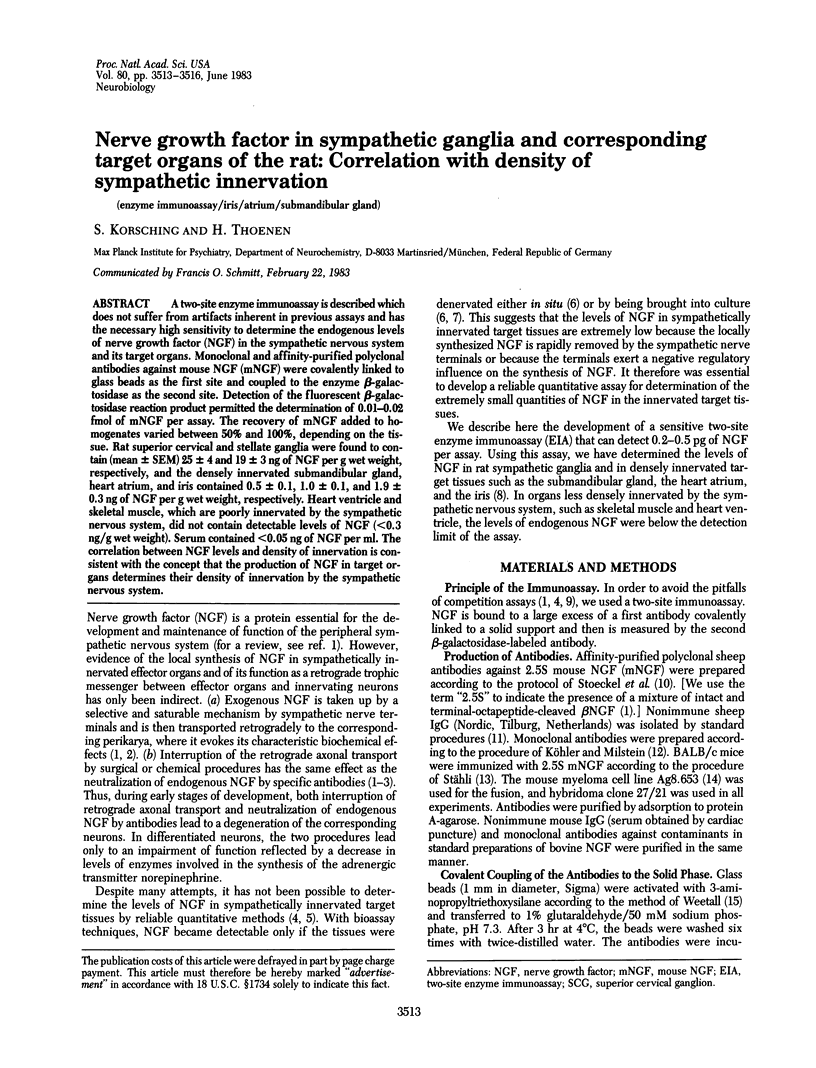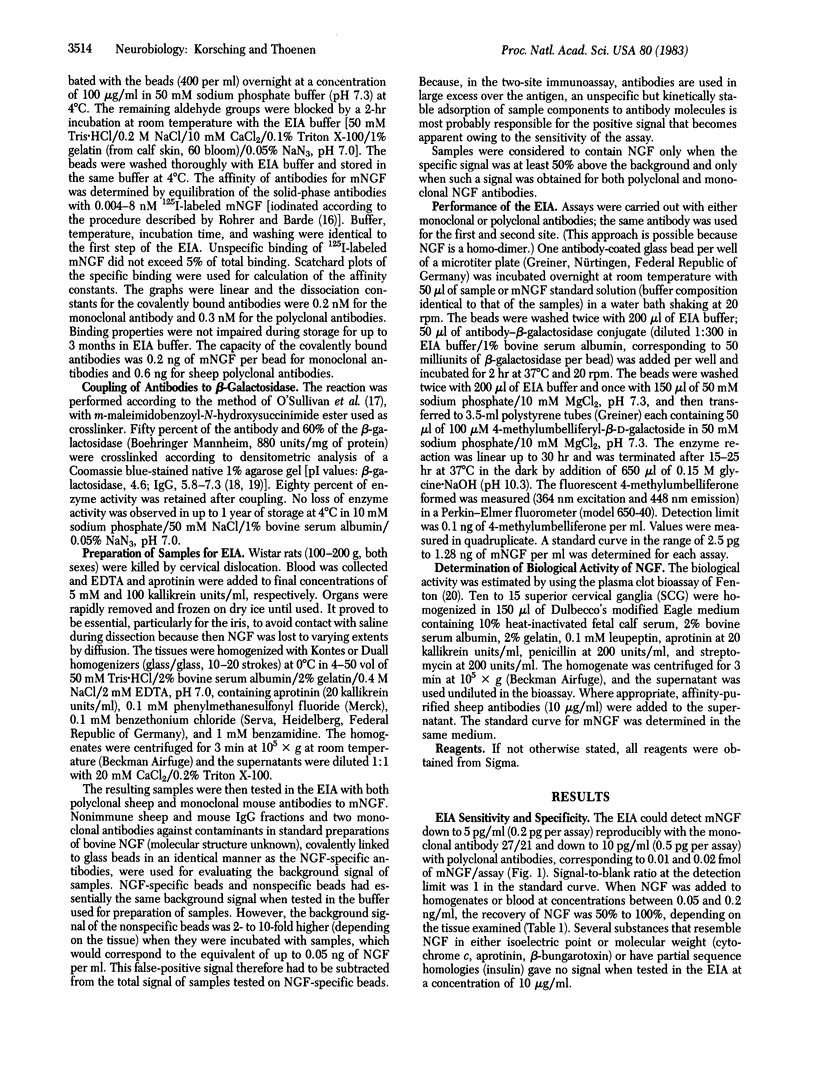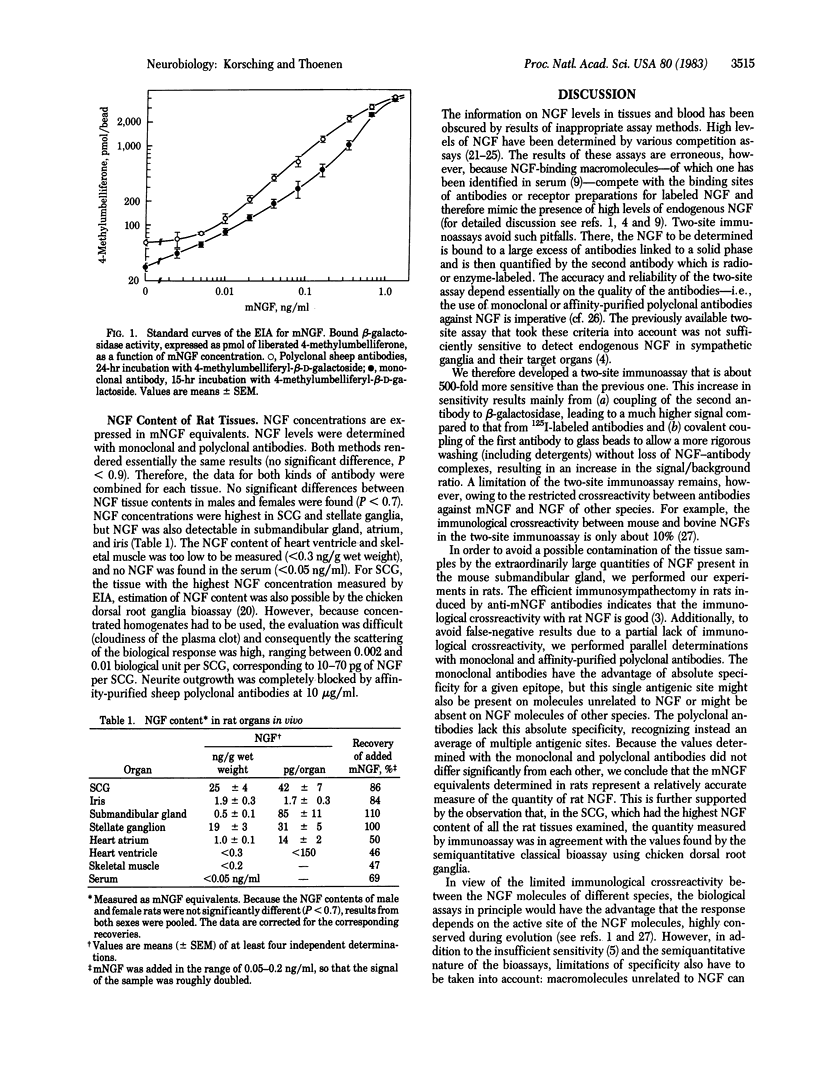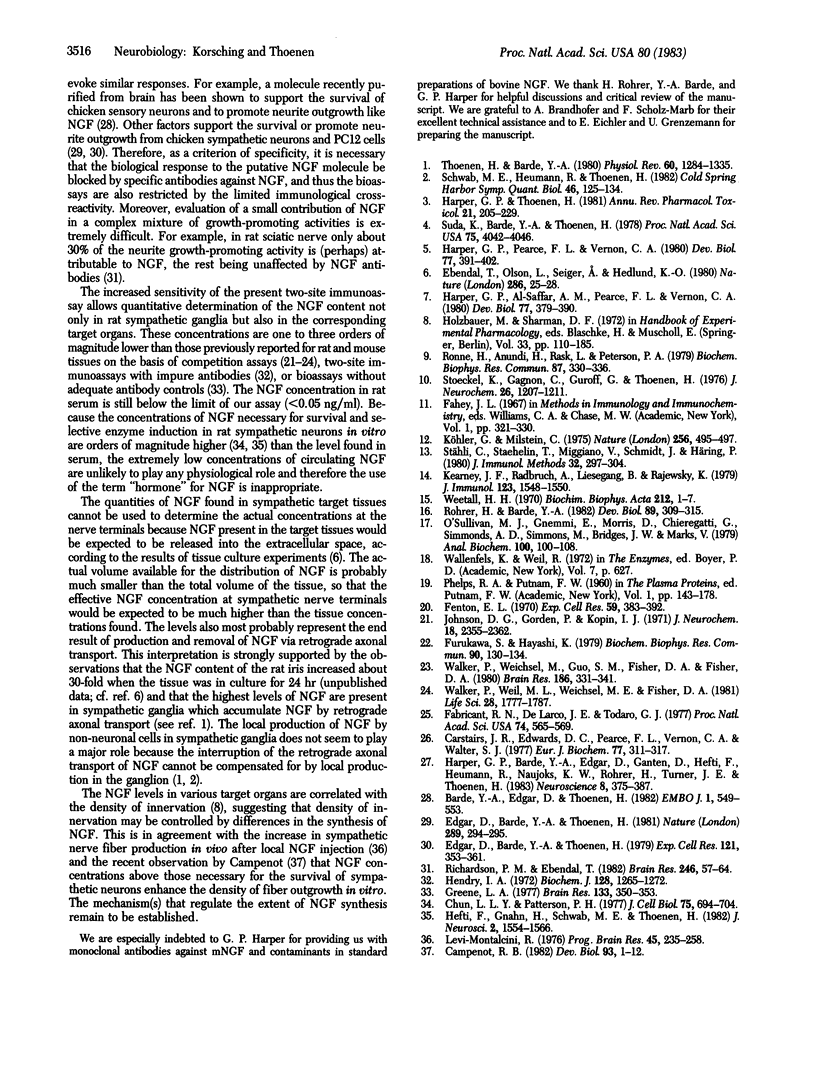Abstract
A two-site enzyme immunoassay is described which does not suffer from artifacts inherent in previous assays and has the necessary high sensitivity to determine the endogenous levels of nerve growth factor (NGF) in the sympathetic nervous system and its target organs. Monoclonal and affinity-purified polyclonal antibodies against mouse NGF (mNGF) were covalently linked to glass beads as the first site and coupled to the enzyme beta-galactosidase as the second site. Detection of the fluorescent beta-galactosidase reaction product permitted the determination of 0.01-0.02 fmol of mNGF per assay. The recovery of mNGF added to homogenates varied between 50% and 100%, depending on the tissue. Rat superior cervical and stellate ganglia were found to contain (mean +/- SEM) 25 +/- 4 and 19 +/- 3 ng of NGF per g wet weight, respectively, and the densely innervated submandibular gland, heart atrium, and iris contained 0.5 +/- 0.1, 1.0 +/- 0.1, and 1.9 +/- 0.3 ng of NGF per g wet weight, respectively. Heart ventricle and skeletal muscle, which are poorly innervated by the sympathetic nervous system, did not contain detectable levels of NGF (less than 0.3 ng/g wet weight). Serum contained less than 0.05 ng of NGF per ml. The correlation between NGF levels and density of innervation is consistent with the concept that the production of NGF in target organs determines their density of innervation by the sympathetic nervous system.
Full text
PDF



Selected References
These references are in PubMed. This may not be the complete list of references from this article.
- Barde Y. A., Edgar D., Thoenen H. Purification of a new neurotrophic factor from mammalian brain. EMBO J. 1982;1(5):549–553. doi: 10.1002/j.1460-2075.1982.tb01207.x. [DOI] [PMC free article] [PubMed] [Google Scholar]
- Campenot R. B. Development of sympathetic neurons in compartmentalized cultures. Il Local control of neurite growth by nerve growth factor. Dev Biol. 1982 Sep;93(1):1–12. doi: 10.1016/0012-1606(82)90232-9. [DOI] [PubMed] [Google Scholar]
- Carstairs J. R., Edwards D. C., Pearce F. L., Vernon C. A., Walter S. J. Immunogenic contaminants in mouse nerve-growth factor. Eur J Biochem. 1977 Jul 15;77(2):311–317. doi: 10.1111/j.1432-1033.1977.tb11669.x. [DOI] [PubMed] [Google Scholar]
- Chun L. L., Patterson P. H. Role of nerve growth factor in the development of rat sympathetic neurons in vitro. I. Survival, growth, and differentiation of catecholamine production. J Cell Biol. 1977 Dec;75(3):694–704. doi: 10.1083/jcb.75.3.694. [DOI] [PMC free article] [PubMed] [Google Scholar]
- Ebendal T., Olson L., Seiger A., Hedlund K. O. Nerve growth factors in the rat iris. Nature. 1980 Jul 3;286(5768):25–28. doi: 10.1038/286025a0. [DOI] [PubMed] [Google Scholar]
- Edgar D., Barde Y. A., Thoenen H. Induction of fibre outgrowth and choline acetyltransferase in PC12 pheochromocytoma cells by conditioned media from glial cells and organ extracts. Exp Cell Res. 1979 Jul;121(2):353–361. doi: 10.1016/0014-4827(79)90015-6. [DOI] [PubMed] [Google Scholar]
- Edgar D., Barde Y. A., Thoenen H. Subpopulations of cultured chick sympathetic neurones differ in their requirements for survival factors. Nature. 1981 Jan 22;289(5795):294–295. doi: 10.1038/289294a0. [DOI] [PubMed] [Google Scholar]
- Fabricant R. N., De Larco J. E., Todaro G. J. Nerve growth factor receptors on human melanoma cells in culture. Proc Natl Acad Sci U S A. 1977 Feb;74(2):565–569. doi: 10.1073/pnas.74.2.565. [DOI] [PMC free article] [PubMed] [Google Scholar]
- Fenton E. L. Tissue culture assay of nerve growth factor and of the specific antiserum. Exp Cell Res. 1970 Mar;59(3):383–392. doi: 10.1016/0014-4827(70)90645-2. [DOI] [PubMed] [Google Scholar]
- Furukawa S., Hayashi K., Ohi T., Imura H. Level of nerve growth factor-like immunoreactivity in the lower limb muscles of muscular dystrophic mice. Biochem Biophys Res Commun. 1979 Sep 12;90(1):130–134. doi: 10.1016/0006-291x(79)91599-7. [DOI] [PubMed] [Google Scholar]
- Green L. A. A quantitative bioassay for nerve growth factor (NGF) activity employing a clonal pheochromocytoma cell line. Brain Res. 1977 Sep 16;133(2):350–353. doi: 10.1016/0006-8993(77)90770-3. [DOI] [PubMed] [Google Scholar]
- Harper G. P., Al-Saffar A. M., Pearce F. L., Vernon C. A. The production of nerve growth factor in vitro by tissues of the mouse, rat, and embryonic chick. Dev Biol. 1980 Jun 15;77(2):379–390. doi: 10.1016/0012-1606(80)90482-0. [DOI] [PubMed] [Google Scholar]
- Harper G. P., Barde Y. A., Edgar D., Ganten D., Hefti F., Heumann R., Naujoks K. W., Rohrer H., Turner J. E., Thoenen H. Biological and immunological properties of the nerve growth factor from bovine seminal plasma: comparison with the properties of mouse nerve growth factor. Neuroscience. 1983;8(2):375–387. doi: 10.1016/0306-4522(83)90073-8. [DOI] [PubMed] [Google Scholar]
- Harper G. P., Pearce F. L., Vernon C. A. The production and storage of nerve growth factor in vivo by tissues of the mouse, rat, guinea pig, hamster, and gerbil. Dev Biol. 1980 Jun 15;77(2):391–402. doi: 10.1016/0012-1606(80)90483-2. [DOI] [PubMed] [Google Scholar]
- Harper G. P., Thoenen H. Target cells, biological effects, and mechanism of action of nerve growth factor and its antibodies. Annu Rev Pharmacol Toxicol. 1981;21:205–229. doi: 10.1146/annurev.pa.21.040181.001225. [DOI] [PubMed] [Google Scholar]
- Hefti F., Gnahn H., Schwab M. E., Thoenen H. Induction of tyrosine hydroxylase by nerve growth factor and by elevated K+ concentrations in cultures of dissociated sympathetic neurons. J Neurosci. 1982 Nov;2(11):1554–1566. doi: 10.1523/JNEUROSCI.02-11-01554.1982. [DOI] [PMC free article] [PubMed] [Google Scholar]
- Hendry I. A. Developmental changes in tissue and plasma concentrations of the biologically active species of nerve growth factor in the mouse, by using a two-site radioimmunoassay. Biochem J. 1972 Aug;128(5):1265–1272. doi: 10.1042/bj1281265. [DOI] [PMC free article] [PubMed] [Google Scholar]
- Johnson D. G., Gorden P., Kopin I. J. A sensitive radioimmunoassay for 7S nerve growth factor antigens in serum and tissues. J Neurochem. 1971 Dec;18(12):2355–2362. doi: 10.1111/j.1471-4159.1971.tb00190.x. [DOI] [PubMed] [Google Scholar]
- Kearney J. F., Radbruch A., Liesegang B., Rajewsky K. A new mouse myeloma cell line that has lost immunoglobulin expression but permits the construction of antibody-secreting hybrid cell lines. J Immunol. 1979 Oct;123(4):1548–1550. [PubMed] [Google Scholar]
- Köhler G., Milstein C. Continuous cultures of fused cells secreting antibody of predefined specificity. Nature. 1975 Aug 7;256(5517):495–497. doi: 10.1038/256495a0. [DOI] [PubMed] [Google Scholar]
- Levi-Montalcini R. The nerve growth factor: its role in growth, differentiation and function of the sympathetic adrenergic neuron. Prog Brain Res. 1976;45:235–258. doi: 10.1016/S0079-6123(08)60993-0. [DOI] [PubMed] [Google Scholar]
- O'Sullivan M. J., Gnemmi E., Morris D., Chieregatti G., Simmonds A. D., Simmons M., Bridges J. W., Marks V. Comparison of two methods of preparing enzyme-antibody conjugates: application of these conjugates for enzyme immunoassay. Anal Biochem. 1979 Nov 15;100(1):100–108. doi: 10.1016/0003-2697(79)90117-9. [DOI] [PubMed] [Google Scholar]
- Richardson P. M., Ebendal T. Nerve growth activities in rat peripheral nerve. Brain Res. 1982 Aug 19;246(1):57–64. doi: 10.1016/0006-8993(82)90141-x. [DOI] [PubMed] [Google Scholar]
- Rohrer H., Barde Y. A. Presence and disappearance of nerve growth factor receptors on sensory neurons in culture. Dev Biol. 1982 Feb;89(2):309–315. doi: 10.1016/0012-1606(82)90320-7. [DOI] [PubMed] [Google Scholar]
- Ronne H., Anundi H., Rask L., Peterson P. A. Nerve growth factor binds to serum alpha-2-macroglobulin. Biochem Biophys Res Commun. 1979 Mar 15;87(1):330–336. doi: 10.1016/0006-291x(79)91683-8. [DOI] [PubMed] [Google Scholar]
- Schwab M. E., Heumann R., Thoenen H. Communication between target organs and nerve cells: retrograde axonal transport and site of action of nerve growth factors. Cold Spring Harb Symp Quant Biol. 1982;46(Pt 1):125–134. doi: 10.1101/sqb.1982.046.01.016. [DOI] [PubMed] [Google Scholar]
- Stoeckel K., Gagnon C., Guroff G., Thoenen H. Purification of nerve growth factor antibodies by affinity chromatography. J Neurochem. 1976 Jun;26(6):1207–1211. doi: 10.1111/j.1471-4159.1976.tb07008.x. [DOI] [PubMed] [Google Scholar]
- Stähli C., Staehelin T., Miggiano V., Schmidt J., Häring P. High frequencies of antigen-specific hybridomas: dependence on immunization parameters and prediction by spleen cell analysis. J Immunol Methods. 1980;32(3):297–304. doi: 10.1016/0022-1759(80)90194-5. [DOI] [PubMed] [Google Scholar]
- Suda K., Barde Y. A., Thoenen H. Nerve growth factor in mouse and rat serum: correlation between bioassay and radioimmunoassay determinations. Proc Natl Acad Sci U S A. 1978 Aug;75(8):4042–4046. doi: 10.1073/pnas.75.8.4042. [DOI] [PMC free article] [PubMed] [Google Scholar]
- Thoenen H., Barde Y. A. Physiology of nerve growth factor. Physiol Rev. 1980 Oct;60(4):1284–1335. doi: 10.1152/physrev.1980.60.4.1284. [DOI] [PubMed] [Google Scholar]
- Walker P., Weichsel M. E., Jr, Guo S. M., Fisher D. A., Fisher D. A. Radioimmunoassay for mouse nerve growth factor (NGF). Effects of thyroxine administration on tissue NGF levels. Brain Res. 1980 Mar 31;186(2):331–341. doi: 10.1016/0006-8993(80)90979-8. [DOI] [PubMed] [Google Scholar]
- Walker P., Weil M. L., Weichsel M. E., Jr, Fisher D. A. Effect of thyroxine on nerve growth factor concentration in neonatal mouse brain. Life Sci. 1981 Apr 13;28(15-16):1777–1787. doi: 10.1016/0024-3205(81)90349-0. [DOI] [PubMed] [Google Scholar]
- Weetall H. H. Storage stability of water-insoluble enzymes convalently coupled to organic and inorganic carriers. Biochim Biophys Acta. 1970 Jul 15;212(1):1–7. doi: 10.1016/0005-2744(70)90171-3. [DOI] [PubMed] [Google Scholar]


